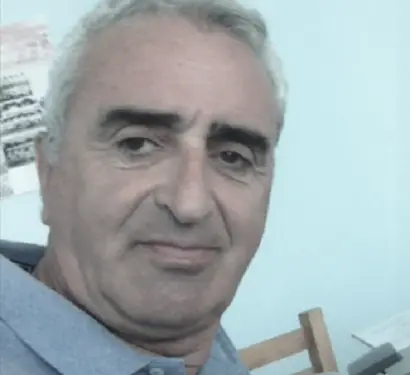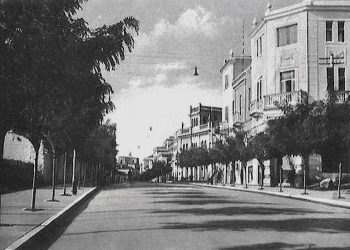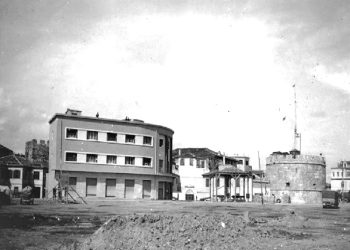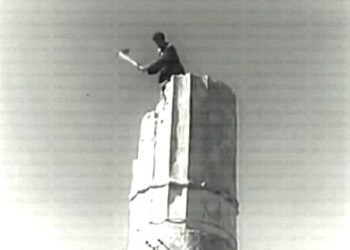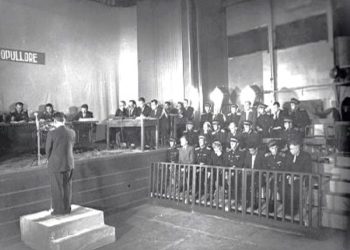From Uvil Zajmi
Memorie.al/ There is little or nothing left of old Tirana today. Only names remain in memory. From “Kursali”, the famous bar at the junction that connected “Durres” Street with “Kavaja”, where the elite of the capital went, stylishly dressed and with brilliantly dyed hair, to famous hotels and restaurants, before 1945 What were they like, who frequented them and how did they disappear from the map of Tirana?! A step back in time for the nostalgic but also the younger generations who would like to know more about the capital of the early 20th century.
The bar “KURSAL”, a non-traditional name!
Little or nothing remains of old Tirana today. Only names remain in memory. From “Kursali”, the famous bar at the junction that connected “Durres” Street with “Kavaja”, where the elite of the capital went, stylishly dressed and with brilliantly dyed hair, to famous hotels and restaurants, before 1945 What were they like, who frequented them and how did they disappear from the map of Tirana?! A step back in time for the nostalgic but also the younger generations who would like to know more about the capital of the early 20th century.
“Kursal” is a word from German and means “kurash room” (Kurhaus”), a recreational building, typical of Northern European architecture in the 19th century, which served mainly as a health center. Quite differently, Tirana’s famous bar, although with the borrowed name “Kursal”, built around the 1930s, was a one-story building, with two towers in the western part, of a Japanese-style architecture.
He had a large hall on the first floor north-south, with about 20 tables, with a modest capacity of up to 100 people, with a front counter, where he was not served standing, but only seated. The hall was designed in a modern fashion for the time, with soft cherry-colored damask drapes running down the middle and a mosaic-tiled floor. A small entrance on the side to first enter his large flower garden, then with a few half-arched steps to the porch that was covered with several tents that was widely frequented in the summer.
The “Kursal” was completed by the flower garden in the shape of a triangle, extending towards the east, surrounded by low railings, with a small fountain, which had in the center the statue of a boy with a fish in his hand, as well as the corner of placing bicycles, a vine with beautiful and fragrant flowers, while outside “Kursal”, one was a cigarette seller. In Tirana, on “Xhemal Pashë Zogu” street, there was another “Kursal”, but it only served as a restaurant.
The most favorite bar in Tirana
“Kursali” was a public, serious, respected and universal café, where people gave and received culture from the behaviors, actions and conversations that accompanied their discussions. Politicians, MPs, high officials, bankers, doctors, intellectuals, owners, sportsmen, artists, foreigners from different countries, people with different preferences, mainly pro-German and pro-Italian, went to “Kursal” who had studied and graduated in these countries, as well as Albanian and Italian traders or former traders, who came to work in Tirana.
It was also frequented by employees of the Municipality, those of the Albanian Bank, mainly for work agreements, including the employees of Radio-Tirana, when they worked with temporary offices in the Municipality building. In addition to the fact that it was in the center of the capital, “Kursal” was given importance, attendance and population as well as fame as a European-style café, with discipline and order. He had cultured staff and served customers with high professionalism.
The waiters served dressed in black suits, waistcoats, white shirts and cherry ribbons or bow ties, as the color of the curtains. In its internal and external environment, not only coffee was served, but everything, as in “Kursal” you could find all the drinks of Europe, from champagne, wine, ouzo, beer, various types of exported liqueurs, but also Albanian drinks. , mainly brandy, beer, as well as cakes, cookies, etc. Drinks did not cost much, as they were priced according to the standard of the time. “Kursali” was also used as a meeting point or the place where taxis or small time vehicles left for other cities.
Also movies in the hall of “KURSAL”.
Films have also been shown at “Kursali”, when in October 1945, the hall that could accommodate up to 180 viewers, turned into “Kinema-Kursali”, a cinema of the second category, which was improvised by removing the tables and adjusting the chairs towards the screen. But, being a narrow hall, the film cameras created difficulties and were close to the spectators. At the request of the spectators, in 1945, the well-known films of those years were shown, together with Albanian documentaries such as “Albania”, made with the help of Yugoslav and then Soviet specialists, with music by Kristo Kono and Dhora Leka.
The “Kursal” cinema was closed after a while as it did not meet the conditions, as well as lack of toilet rooms, the cameras were for large cinemas, etc., but also due to the fact that the Sport-Club “Tirana” would be located there. In 1938, a special dance school salon was opened in the “Kursal” café, by prof. Stathi and its surroundings have opened painting exhibitions of Albanian artists, such as Abdurrahim Buza, Kel Kodheli, Andrea Kushi, etc.
“KURSALI” of famous poker….!
Even for this fact, “Kursali” was known and remains unique, since gambling was also played there, both before the 40s and after 45, but with restrictions, until it was banned by law. In the western part, “Kursali” had 6 rooms, a real labyrinth that was closed with curtains, so that others could not see where it was played. Deputies, ministers, military, federal, Albanian and foreign merchants, personnel of the diplomatic corps, accredited consulates in Tirana went there, who systematically played gambling and the favorite game was poker, then billiards, up to chess, dominoes, as games of that layer that possessed European culture and preferences.
There were times when one of the towers did not work or was closed, as it was used for those who gambled for extended hours or days. In addition to the two poker towers, a notary stood in an antechamber as a person-guarantor for the amounts of money that people played. Everyone gambled there, but the merchants were the most active, using all the currencies of the time, as well as the Albanian lALL, which was strong for that period. During religious holidays, such as Easter, Christmas or New Year’s, the game of gambling was opened publicly as a form where the attendees, but also the general population, could try their luck. In the premises of “Kursal” visas were also issued, mainly for Italy.
Proms and expensive weddings
He was a favorite for end-of-year holidays, especially for religious ones, but the peak of his attendance was New Year’s, which had a different design, organizing evenings, balls, etc. Not being a restaurant, such events were served with catering and the kitchen was brought by Lluka Papadhopulli, from the “Europa” restaurant, which was located in front of it. In “Kursal”, very expensive lunches and dinners, anniversaries and weddings were organized, which were also held in its flower garden, also due to the fact that the wedding was attended by the citizens of Tirana. This, in order to give fame and name to those who got married, who were mostly children of rich people from well-known Tirana families, mainly as regular attendees of “Kursal”, organized engagement ceremonies in reserved rooms and premises his.
Orchestra, with modern music and entertainment
Mainly before 45, in “Kursal” fun music of the time was practiced. In his book, “Tirana 1920-1944”, the well-known writer and researcher, Spiro Mhilli, among others, writes: “Kafe-Kursal”, every day, after 10:00 in the evening, organized the famous and artistic ballet with five girls “Caprice Girls” and with the participation of the Hungarian gypsy orchestra, directed by maestro Mago Kololy from Budapest. The ballet and dances of the five Hungarian beauties were often replaced by new programs. The talented violinist Riccardo De Mucci performed in that bar. The concerts started at 18.00 in the afternoon and after a break, they resumed after 22.00 in the evening and the ticket cost 5 ALL (old).
Director Fuat Alim and owner Shefik Kondi, often enriched the program with ‘Trio-Rianda’, with Spanish dances, Argentine tango, various songs, modern classical music performed by dancers such as: Anete Danau, Mimi Mihaillovna, Parru Grseden, and singers from Italy. On Sundays and holidays, the program started at 5:30 p.m. A few years later, Pjetër Gjini and Ali Begeja became guitarists. Its owner brought an Italian girl named Rozana as a waitress, for whom a song was composed that was preferred by those present, who filled the bar and there was not a single empty seat.
Unlimited music and passion…!
The same ritual continued in the years that followed, when there was orchestral music every evening after 18:00, from Tuesday to Sunday, with Monday off, while the bar never closed. During the time the orchestra was working, preserving an early tradition, each drink cost 2 ALL more and the glass of frenet, as a favorite drink, was dressed with sugar.
In the winter or even in other seasons when it was cold, the orchestra and the singer stood on a podium next to the counter, while in the summer it was placed in the left corner, on the veranda. The singers performed modern Albanian and foreign songs, and among the names still remembered by the elderly are: Brixhilda, the beautiful blonde singer, together with Lin Ndokë, from Shkodra with the special voice, when she performed Italian songs of the time, Kasem Alluni, Toni Prosi, Keli, orchestra players from the Skoza brothers, Alfons Balliçi, Bahiri with sax, each with opportunities and offers, have been its protagonists. All the well-known orchestra players of the time fell in love with the instruments and had the desire to perform in “Kursal”.
“KURSALI” of brilliantine
It was hard to find there, at least until the beginning of the 60s, men with hair without the brilliance which, inherited from the “time of Italy”, was sold in small oil-shaped bottles and was of great use to the boys of men of those years. Even for a coffee in the morning, or in the evenings at “Kursal”, they had to shine their hair brilliantly, as a modern indicator of the time, even in relationships with women, they were more preferred. Likewise, the orchestras, the singers… all brilliant.
Meanwhile, “Kursali” was not very frequented by girls and women, who alone could not attend “Kursali”. But those who served were also special, from Mira, Llambi, Besimi, and Kamberi, the veteran wife Vasilika Kareco, who is now in Greece, and many others, but above all Kadri Morava, the head waiter, the legendary man of “Kursal”, with several decades of service there.
Who was the head waiter Kadri Morava?
Very elegant, over 190 cm tall, he held up to five beer mugs in each hand. In “Kursal” the gratuity was high (over 100 ALL) and the pleasure of paying and offering lunch and dinner to the guests was great, even wine was practiced there, paying off the expenses later. In many cases, it was closed after midnight, to open early in the morning. His two annexes were booked by clients who were from the stratum of elite society, such as: doctors, sportsmen, artists, politicians, officials, educated in the West, translators, publicists, charming boys of the time, without a doubt, from those with brilliance.
“KURSALI” in the memoirs of the well-known publicist, Gjergj Bubani
“A little further, in the middle of a square, a beautiful garden and on its edge a modern building: “Kursali”! The City Hall’s brewery-café, the only roasting place in the Arbno capital, where Marçela serves elegantly…….”!
The writing of Gjergj Bubani: “SKILL AND GO THROUGH TIRANA”
“With an orchestra in ‘Kursal’. 17:58. After two minutes the orchestra begins and its first sounds decree ipso-fackto, the double price tariff. Exhausted by the July heat, the gardener empties the glass of arançata to the bottom and calls the waiter. He wants to pay as much as the tariff “with music” was decreed.
But Dionysus is too busy; he is content to answer with a long “yes” without even thinking about it. The hour passes. The musicians have already occupied their seats and are setting up their instruments. The plan is not yet a decree, but a warning of the decree. The customer knocks on the table repeatedly, persistently.
Dionysus does not listen, or he has other work and pretends not to listen. The hour passes. The violinist stood up, distributed the parts of the notes and is ready to give the starting signal. Mistery begins to break out in a cold sweat. He jumps from his seat and grabs the violinist’s hand: Scusate maestro! Small prima payare io! (Sorry maestro! I want to pay first!). Sometimes the “Kursal” garden is full.
Men of every rank and every category, big politicians and small officials, come to rest and continue the short conversation around the straw tables, refreshing themselves with a glass of “Sinalko”. But… only men. Lobster it becomes your eye to see a female face. In these circumstances, anyone can guess how big a role the waitress, with bright eyes and constant smile, of ‘Kursal’…!
Marçela is an Italian chick, with a beautiful figure, bright eyes and rhythmic body movements, the pampered guest of ‘Kursal’. A colleague from Tirana, Mr. Nebil Çika, dedicated an article of worship to him. And revenge. That Marcela tears in Tirana a civilizing role. “If it wasn’t for Marcela,” my colleague Mr. Milto Gura, – ‘Kursal’ would seem to me to be a pederast club. And rightfully so.” (Gjergj Bubani, publicist, Selected Works 1 and 2).
“KURSALI”, also Address Office
A room in a small corridor, which was climbed by a few steps, in the southern part between the two towers, for many years until it was demolished, served and was the Address Office of Tirana, where you could find an employee who after checking through his notebooks, to accurately show the street, the number of the building or the house, everything detailed about the person.
It was open almost all day, until midnight. It was unique and very important for the time. It helped you find people, family members, when their movement at that time was chaotic and not systematized. Around “Kursal”, to the left, to the right and behind it, there were urban bus stations that carried out the transportation of citizens from the center to Kombinat, Laprakë and Kinostudio and a dispatch office for the urban lines of the capital.
Bar “EUROPA”, also liked by the Royal family
Very well-known for its time, restaurant – café – hotel “Europa”, owned by Lluka Papadhopulli, was a two-story building almost in the southern part of the Old Market, next to the Clock Mosque in the center of Tirana. Although Lluka, his friends and companions were regular visitors to “Kursal”, in the surroundings of “Europa” they served and cooked very well, even the staff of “Kursal” came there for lunch and dinner.
Lluka, first worked as a cook at “International”, then at Palati i Zogut, as he had many friendships with Princess Sanije, the sister of King Zog. He was the one who cooked and served the Royal family’s banquets, and he even delivered the family’s lunch. After Zog, Lluka was taken by the Italians, while during the years of socialism; he served in the former Bloc of the senior leadership of PPSh. A very honest man, from America, Austria, where he learned the art of cooking, then in France, before coming to Albania with Habibi from Gjirokastria, he built hotel – café – restaurant “Europa”.
“BELLA VENEZIA”, another preference…!
Café “Bella Venezia”, on the main boulevard of the capital, was a bar with an intense attendance in the mid-60s and 70s, when it also got the name “Tirana” Cafe-Pasticceri. Spacious, well furnished, it had a comfortable and modern environment, where it was served only on the first floor, as there was a flat above. Drinks, cakes and ice cream were also served there. There were luxurious, high, upholstered seats. Bar with many lights and colors, with a counter that was in front of it.
Among the attendees was Dhimitër Shuteriqi, (the legendary president of the League of Writers and Artists of Albania who lived above the bar and had his desk there that no one could occupy even when he was not there), but also the other writer of known, Petro Marko, who before returning to his apartment, a little further, (somewhere in front of “Voice of the People”), made a turn at that café.
CAFE “CENTRE”, “ILIRIA”, “DURDURSI”, HOUSE OF OFFICERS
These bars were in the center of the capital, in front of the old City Hall building, and while the first two were Bar-Cafe, “Durrësi” was a hotel-restaurant, where for many years before and after the war, football teams gathered, mainly those of Sport-Club of Tirana, whose athletes have systematically attended it and later those of Cirku and Estrada, such as Telat Agolli, brothers Arjan and Don Miluka, etc.
Meanwhile, in Tirana, the House of Officers of the Ministry of People’s Defense had a good attendance, (the former home of Musa Juka, the minister of the interior of the Zogu Monarchy), where gambling was played in its basement hall for a long time. but the bar-café restaurant was massively preferred for major officers, then for the middle class citizens and artists, when it was transformed into the League of Writers and Artists of Albania.
It is the period when other Bar-Cafes were opened on the boulevard, in the center and on the main streets of Tirana, together with “Flora”, the one on the third floor of the Palace of Culture, the hotel “Arbëria” and “Arbana”, on the 15 – floors, (Tirana-International), as well as “Vollga”, which remained classic with Bar-Sahati next to it, for those coming to “Rinia” café (“Taiwan” today). However, despite the changes and preferences that time brought, “Kursali” remains the first and modern location in Tirana of those years.
Drastic breakdowns after 1945
Few names were preserved after 1945. Streets, squares, locales took the names of heroes, communist exponents, events and dates marked by the period of the National Liberation War, taking the example of the Soviet Union. The first blow was given by the demolition of the “Old Market” with the premises and everything that surrounded it, since in 1959 – ’60s, the construction of the great Palace of Culture began there; even Nikita Khrushchev himself laid the first stone the leader of the Soviet Union, who succeeded Stalin in that post.
Ten years later, for the construction of the 15-storey building (Tirana-International), all the buildings, bars and restaurants on the boulevard and on “Rrugën e Dibra” were demolished, to be followed by the demolition of the City Hall building located in the center of “Skënderbej” Square. For the construction of this building (later, the Executive Committee of Tirana), the works started on May 12, 1930, when the mayor Rexhep Jella, together with the prefect Rauf Fico, laid the first stone in the foundation of the building.
The works of that building were completed on September 1, 1931, the date when it was inaugurated in the presence of the princesses with a special ceremony. It was a Western-style, two-story building, in harmony with the Italianate architecture of the surrounding buildings. Both the City Hall, “Kursal” and “Rinia” survived until 1980, when in order to build the Historical Museum, the building of the City Hall (then called the Executive Committee) was blown up with dynamite, including everything else in the eastern part, leave a space until the “Ali Kelmendi” Palace of Culture, whose building has taken on other functions today.
After the 90s, several bars with the name “Kursal” were opened in Tirana, but without the structure or architecture of the former famous bar. It seems that the creators are content to inherit only the name, hoping that the bar will have the fame and attendance of that mythical one, which began and shone during the years of the Bird Monarchy and the period of the country’s occupation (1939-1944), as well as several years of others in the communist regime, but without its former glory. Memorie.al




